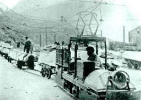LSWR Cavalier
Established Member
Not for me. May we have another clue, or just the answer? Setting questions is difficult, often they are too hard or too easy.It was GTR...
That makes it too easy!
Not for me. May we have another clue, or just the answer? Setting questions is difficult, often they are too hard or too easy.It was GTR...
That makes it too easy!
All ingenious ideas but not the right answer, although you are focusing on the right industry. Emil Kolben was a Czech, if that helps. He was born in 1862 and died in the Terezin (Theresienstadt) concentration camp in 1943. He should be much better remembered than he is.Kolben is a bit like the German word for piston, could that be something to do with it? Or did he devise something to get the locomotives up the terraces at Dinorwic? Or to put narrow-gauge wagons sideways on 4' gauge wagons for the Penrhyn quarry?
Now you are getting there - but I want something a bit more railway-related than that. And do you happen to know which workings?Electrification driven by a water powered turbine which supplied light and power to underground workings
Not as far as I know. The inclines to the quarry/mine I am thinking of (like most in North Wales) were balanced/gravity worked - i.e. the loaded wagons coming down raised the empty ones going up.Haulage of wagons up inclined planes?
Not at Blaenau, but not far away. The thing Mr Kolben designed was directly related to the railway aspect of the quarry/mine in question and is thought to have been the first in Wales.Slate was mined underground at Blaenau, was it there? Dinorwic and Penrhyn/Bethesda were 'open cast' mainly I think. Did his inventions help power tools for cutting slate, and pumps to keep the workings dry?
Not in the Nantlle valley.Pen-yr-Orsedd, I believe.
That's right - Emil Kolben was an early electrical engineer who was born in Bohemia, studied in Prague, trained in the US with Thomas Edison and Nicolai Tesla and then returned to Europe, initially to work for Oerlikon in Switzerland and then in 1896 to set up his own company in Prague. By the early 1900s he was making the complete works - hydro-electric power stations with turbines and generators and electric locomotives with all the trimmings. The first Croesor locomotive (30hp, 220vDC OLE) was designed and built in his works in Prague in 1904 and it seems to have been the first electric loco in Wales. (My guess is that Kolben engineered the whole package including the power station). His company became part of CKD and manufactured the most successful tram in the world in terms of numbers made - also motorbikes, mining machinery and lots of other things. After a long history it was taken over by Slemens in 2002. A picture of the loco is below.Both the Croesor Quarry and Llechwedd quarry had electric locomotives so was it one of them?

Sorry, have edited it to U.K.Ah, but world-wide; or more limited geographically, than that? Should world-wide, be appropriate: I'll go for the Russian class E (in Cyrillic, looks something like 3) 0-10-0: don't know the number, with any precision; but at all events, many thousands.
Sorry, I was meaning TOPS class, but even so, fewer Black 5s were made than this.Black 5?
Well done!Class 08?
Sorry, neither is correct.Train left at 12:22? Or December 1922, just before the Grouping?
